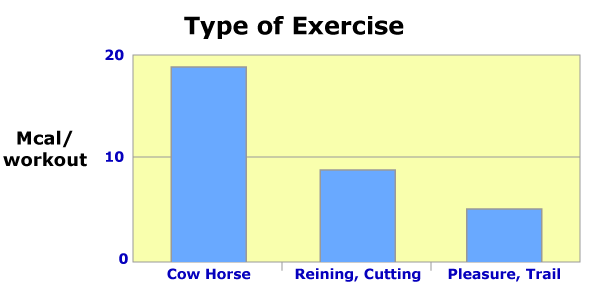Previous Page | Right click this page to print.
Workload
Workload has been categorized into three different groups by the National Research Council; the light working horse, the moderately working horse and the intensely or hard working horse. A light working horse would be a pleasure horse, trail horse. Moderately working horses are raining horses, cutting horses, dressage horses would fall into this category. Jumpers. And heavier intensity working horses are most cow horses and sometimes a three year old reining fraturity horse would fall into this category if they are worked pretty hard. Race horses would also fall into the heavy working category here.
Here is an illustration of the energy need above maintenance.

You can imagine if the energy at maintenance is all the way on the bottom. The cow horse is probably one of the ones that needs the most energy above maintenance versus some of these other ones. Also, again the race horse would fall into this category and the three day eventer and so forth. Why would you think that a cow horse would needs so much more energy than say a trail horse? If you look at the nature of the work, a cow horse does versus that of a trail horse and you add up all the amount of work they do over a 24 hour period, it makes sense that they need about at least twice as much energy above maintenance as a trail or pleasure horse would.
The best way to basically start out calculating rations for horses is
as a percentage of their body weight.
Light |
1.5- 2.0 |
Moderate |
1.75- 2.5 |
Intense |
2.25- 3.0 |
A light working horse should eat anywhere from 1.5% to 2% of his body weight in total feed and that includes hay and grain. And that goes all the way up to about 3%, in the heavy working horse. In addition to the total intake going up, we have to manipulate the hay to grain ratio as the horse works harder.
| Light | 70:30 |
| Moderate | 60:40 |
| Intense | 50:50 |
| Minimum of 1% BW in hay | |
The light working horse should eat about 70% of his total intake, by weight, in hay and about 30% in grain or concentrate feed. The moderately working horse, it goes down to 60:40 and for the intensely working horse it goes down to 50:50. Now the main reason that the grain portion goes up is because that is where most of the calories are, that is where the greatest chunk of the digestible energy is coming from. It is not from the hay. The hay mainly provides the fiber. And if you feed high quality alfalfa, it provides a lot of the protein as well. But, most of the energy, which is what goes up the most in the performance horse, comes from the grain. Therefore, the hay to grain ratio, the grain portion of it goes up. One of the most important things though is that we have to keep a minimum of 1% of the horses body weight in roughage in the diet. Why do you think that is so important in the horse? What could you imagine would happen if we fed too much grain and we were not feeding a minimal of 1% of the horse’s body weight in long roughage? Basically, what you would see is all kinds of intestinal-digestional problems, because they need that particle size in order to maintain proper gut function.
So light working horse needs about 18 to 22 megacalories of digestible
energy per day. Moderately working horse anywhere from 20 to 30 megacalories
per day. Totally depends on the horse’s weight and whether or not
they are an easy keeper meaning they have a slow metabolism or they are
a harder keeper meaning they have a faster basal metabolism. And the hard
working horse, intensely working horse needs upwards of 30 megacalories
a day. If you look at your own diet, how many megacalories do you eat
per day? About 2 to 3, some of us probably up to 4. So you are eating
a lot less, it will be about 10 to 15 to 20% of what a horse will eat.
Previous Page | Right click this page to print.